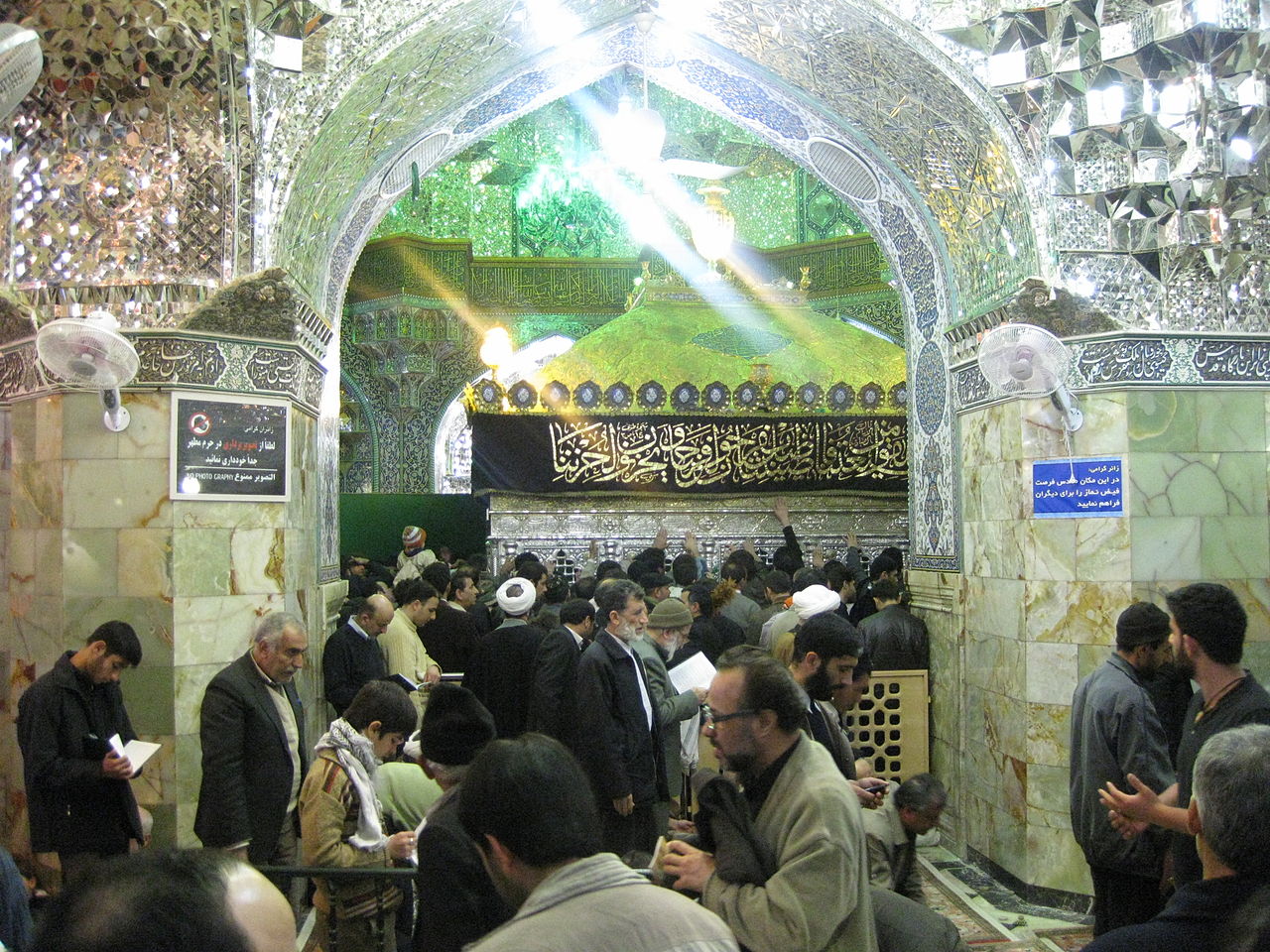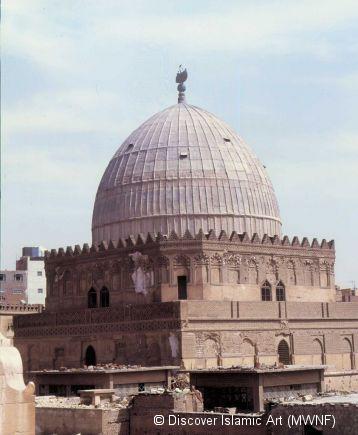4. The “visit” to the saints
The "visit" (zyara) to "the friends of God", the awliya' Allah, is a very popular practice. The zyara is a beneficent visit that spread in the entire Muslim world. It includes manifestations of devotion, prayers, offerings and wishes, which many authors have virulently denounced since Ibn Taymiyyah based on theological and religious grounds: God is unique and does not have a “companion” and only he can be worshiped. Despite these denunciations, the zyara on the tombs of saints has been greatly developed and encouraged given of the advances in transportation. What are the powers given to the saints? Are the rites of this "visit" specific or do they imitate the rites reserved for the pilgrimages in the great holy cities of Islam? What are the arguments of those who condemn these practices of devotion?
The tomb of Fatima Ma’sumah in Qom (Iran)

Wikimedia Commons. Usable under the conditions of the GNU Free Documentation License:
Public domain. Image under URL:
http://commons.wikimedia.org/wiki/File:Fatimah_Ma%27sumah_Shrine_Qom_14.jpg
Twelver Shi'ites worship Fatima al-Ma'sumah because of her proximity to the family of imams. As the daughter of the seventh imam of Shi'ites, she reportedly died after being poisoned by the Abbasids while going to visit her brother Reza, the eighth imam of Shi'ites (see module Islam I, page 5). She was also called Ma'sumah, which means the Pure one, the Innocent one. Several miracles have been attributed to her. His tomb is located in the university mosque of the city of Qom, Iran. The building has been embellished over the course of the centuries, in particular by the dynasty of Safavids who adopted Shi'ism as the official religion. Because of its imposing dimensions, the sanctuary, which was renovated in the nineteenth century, is towered by six minarets and a golden dome. A huge burial chamber of over four meters high sits on the cenotaph. The mullahs can be recognized through their white turbans.
The visit to Fatima Ma’sumah
[…] the keeping of the sanctuary by professional clergy avoids potential drifts to private worship. On his arrival to the sacred enclosure, the pilgrim is usually requested to be accompanied by a professional prior, or rather by a teller of prayers, who will whisper to his ears the best words he can tell to the saint and her family [...].
After taking out his shoes at the entrance, the pilgrim will enter with open hands to receive blessings in the hall around the holy shrine. There, a constant rumour will help his fervour, with tears and sobs, with reciters of the Quran, with incantatory prayers. In this holy place full of pious emotion, to cry is the normal attitude, with tears to offer so that they relieve the heart. The pilgrim cries in communion with his imām, with the twelve Imāms and with their families. He puts himself in the place of the companions of the imām, and with his tears he forgets for a moment the many mediocrities of daily life. Meditation around the saint is perpetually set in motion by a crowd of pilgrims walking in ritual circumambulation. They scramble to kiss the gate of the shrine for an instant, and possibly slip an offering through a gap, in the form of a note, an invocation or a wish.
Yann Richard, « Qom, un lieu sacré en Iran », Lieux d'islam, Autrement Collection Monde Paris, H.S. N° 91-92, février 1996, p. 65-66. Trans. Marie Lebert.
The pilgrims perform specific rites, recitations of Quranic verses, greetings and circumambulations (such as those prescribed in the pilgrimage to Mecca) around the burial chamber. The completion of this rite is an essential precondition before one can receive the blessing by any saint. The authorities responsible for this very popular sanctuary have to frequently regulate the flow of pilgrims to avoid overcrowding.
The legality of the zyara
Allah has specified some places symbolizing His honour and dignity like, Ka'bah (…). People have been inspired and blessed with an ardent desire to visit these places so that they may flock here from all the nooks and corners of the world, whether mounted on the backs of animals, or traveling on foot, they all come from afar to witness the House of Allah, bearing the hardships of journey, wearing specified unsewn clothes, reaching there in a peculiar guise and assuming a typical physiognomy, offering sacrifices in the Name of Allah, completing their vows, circumambulating the House of Allah and fulfilling their innermost aspirations towards expressing their gratitude to their Lord upon reaching there (…) However, all the above things are observed to pay one's homage and tributes to Allah and to express one's honour and gratitude towards Him. (...)
Therefore, carrying out these activities to propitiate any other entity other than Allah is forbidden and regarded as an act of Shirk. Traveling to distant places and bearing the rigors of travel merely to visit a grave or a sanctum of a saint in tattered and dirty clothes, offering animal sacrifices upon reaching there, completing one's vows there, circumambulating someone's house or a grave, respecting the forest around it, abstaining from hunting there, not cutting trees there, not pulling out the grass and straws from there, carrying out the other similar activities and looking forward to the goodness in this world and the Hereafter (out of performing these activities) are all acts of Shirk which one must avoid.
Isma'il Shahid, Taqwiyat-ul-Iman (The Strenthening of Faith), 1824.
Isma'il Shahid (1779-1831) was a Sunni religious reformer from India. In the beginning of the nineteenth century, the Mughal dynasty had lost its power, and India was administered by the British Empire and the East India Company in Calcutta. Wahhabism was influential among Muslim scholars in India. Isma'il Shahid in his work The Strengthening of Faith reveals the doctrine of the oneness of God and encourages the Muslims of India to go on the great pilgrimage, the hajj (the fifth pillar of Islam), which at the time was rarely practiced by the Muslims of India. His work, one of the first religious books written in vernacular Urdu, was largely disseminated among the popular classes. He denounced the worship of saints, which was considered by fundamentalist reformers as an unpardonable type of associationism (in Arabic shirk) and a punishable act of innovation. The rites of the hajj, including the tawaf (the seven circles around the Ka'ba), the acts of bowing, and worship must be reserved for God alone.
The mausoleum of the great jurist al-Shafi’i (Cairo)
The most visited of all tombs [of the large cemetery known as City of the Dead] is the tomb of the Imam Shafi'i, in which lay the remains of a great scholar, founder of the rite that bears his name (Shafi’ite), who died in 820. The tomb we can see today is a beautiful building of the Ayyubid period. Its dome, dating from 1772, is topped by a metal boat that was once filled with oil and wheat during pilgrimages [...] ... people come from all Egypt to bring letters to ImamShafi'i: they are crept into the gate of the shrine in order to obtain some favor, while gifts are slipped into a box.

The mausoleum of the great jurist al-Shafi’i (Cairo).
http://www.explorewithmwnf.net/m...1&mid=329
Catherine Mayeur-Jaouen, "Coupoles et minarets l’Égypte" Lieux d'islam, La Découverte, Autrement Coll. Monde HS n° 91-92, 1996 p. 124-125.
The tomb of the imam Shafi'i [see module Islam I, page 7] was built in a vast necropolis admired by the Arab travellers in the Middle Ages. People would go on a pilgrimage to the supposed tombs of the Companions and People of the Prophet’s family. There are also the mausoleums of the sultans and saints. This important place of worship attracts mostly women on Fridays or during major religious holidays.
The supplications and letters by Muslims addressed to the imam show that the fervour in his regard has not faded. They are very diverse and connected to the daily life of the Egyptians. People appeal to him for healing, or for help finding a missing chicken or murderers on the run. The miracles attributed to him have contributed to his fame throughout Egypt.






